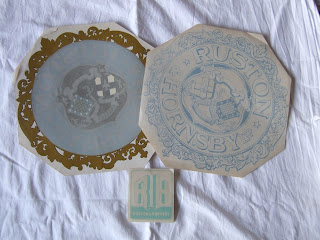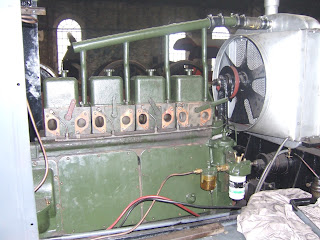The choice of livery for a locomotive can be controversial and the cause of much heated argument among railway enthusiasts. Hopefully the proposed livery for Queen Anne will not stir up too much trouble.
As can be seen from the image at the top of the blog, QA has panels advertising Queen Anne whisky on a strange beige coloured background with white lining. An earlier colour photograph shows the same adverts against a greenish background, but with subtly different lining, so the background must have been repainted at some point. It is likely that the locomotive never ran at Longmorn with this colour scheme, but was painted specially for delivery to the Strathspey Railway in 1980. QA was delivered to Longmorn painted in green with white lining and white buffers, and ran in this state until 1980 when the distillery’s private rail network closed.
Pure Ruston
While many industrial customers for Ruston & Hornsby’s locomotives would ask for their loco to be painted in their company colours, it appears that the distillery did not specify any such colour scheme, so the locomotive was delivered in R&H’s own standard livery at the time (1948). This consisted of “Ruston Green” (also known variously as Lincoln Green or Verdigris Green, BS381C Shade 276) on most of the locomotive and inside the cab with white lining, red buffer beams (exact shade unknown) and a black cab roof. There was a Ruston & Hornsby crest on the side of the cab, and RH monograms inside the cab. The green background at the top of this blog is "Ruston Green".
There are sufficient black & white photographs of the locomotive at work at the distillery to re-create the white lining. Some “paint archaeology” has exposed the original crest on the cab sides so that its size and position could be determined. No colour photographs of the locomotive at work have been found so far.
There are sufficient black & white photographs of the locomotive at work at the distillery to re-create the white lining. Some “paint archaeology” has exposed the original crest on the cab sides so that its size and position could be determined. No colour photographs of the locomotive at work have been found so far.
 |
| The original Ruston crest on the cab side exposed |
 |
| Some original Ruston transfers have been purchased for the cab |
There are quite a few Ruston 48DS locomotives in existence, although only a few are in working order, and none are in pure Ruston livery. This is another good reason to restore Queen Anne as closely as possible to its as-delivered state.The locomotive never carried a number or name while at Longmorn, but since arriving at the Strathspey Railway it has been known as Queen Anne because of its advertising panels. For this reason it has been decided to cast Queen Anne nameplates to be fitted on the upper bonnet of the loco. For those people wishing to take photographs in completely “Pure Ruston” condition, they could be removed temporarily in exchange for a £20 donation to locomotive restoration.
The Queen Anne advertising panels have been photographed and reproduced using desktop publishing software. The artwork is in the form of actual size print-ready PDF files, so could easily be printed as self-adhesive vinyls or magnetic sheets at fairly low cost. So it would be possible to temporarily create something approaching the “Queen Anne” of the 1980s if required.
The Queen Anne advertising panels have been photographed and reproduced using desktop publishing software. The artwork is in the form of actual size print-ready PDF files, so could easily be printed as self-adhesive vinyls or magnetic sheets at fairly low cost. So it would be possible to temporarily create something approaching the “Queen Anne” of the 1980s if required.
 |
| Original Queen Anne advertising panel |
 |
| Reconstructed artwork using best-match modern fonts |
Hopefully reverting to the original livery will appeal to those who would like to see an accurate restoration of a distillery shunter as well as fans of Ruston & Hornsby locomotives.
Latest Updates
The reconditioned cylinder heads have now been put back on.
 |
| The Ruston 4VRH engine on 16th July 2016 |
 |
| The right hand side of the engine on 16th July 2016 |
Also, the GNSRA article on Queen Anne can now be seen on the "Queen Anne History" page.






